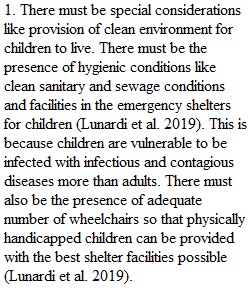


Q Children are especially vulnerable to disasters. Their psychosocial responses are influenced by their physical and psychological composition and by their interactions within their social influence including their family, neighborhood, community, and larger society. 1. What are some special considerations in protecting children and other vulnerable populations during disasters? 2. How can a “system of care” approach, a comprehensive network of child-serving programs including health and mental health, education, welfare, justice, and other child services as well as natural community support services such as faith-based and consumer programs organized to meet the needs of the children and families they serve during disasters? 3. How can better education and training along with a "system of care" approach reduce the risk associated with emergencies and disasters? Additional information on the System of Care approach: http://www.thefamilygateway.net/supports-services/system-of-care/what-is-a-system-of-care/ ************************************************************************************************************************************* ALL FORUMS Initial Response: Initial responses should be no less than 450 words in length not including your reference(s) and supported by at least two references (aside from the textbook). Initial responses are due no later than 11:55 p.m. ET on Wednesday, Day 3 of each week. This allows time for other students to respond to your initial response. Please be aware that just “cutting and pasting” sections of articles (in lieu of writing an original initial post) is not acceptable and will negatively impact your grade. Peer Responses: Students are required to respond to at least two (2) other student’s initial postings (and the instructor) with significant comments that have substance. Peer responses are due no later than 11:55 p.m. ET on Sunday, Day 7 of each week. All peer responses must be substantial and significant and should be no less than 200 words in length not including your reference(s) and supported by at least one reference (aside from the textbook). If possible, one of the responses to another’s work should be from an opposing viewpoint. Your response to your peers work should be engaging and informative with good substance (just stating “I agree…” is not acceptable). Your responses should contribute in a meaningful way to helping advance our knowledge of the topics the class explores. Your responses to another’s work should be posted as a sub-thread to the student’s original posting of whom you are commenting. For all Forum activity, students are encouraged to use the APUS Online Library to search for references that help support their argument (in addition to textbook material). All posts should contribute and advance the class knowledge of the course themes. The Forum provides an opportunity for everyone to analyze work from many different perspectives. Late Forum posts receive a 10% per day late penalty. If your 2 peer responses are posted after the week is ended (after Day 7, Sunday) they receive a zero, in that the discussion is over and you cannot receive credit for participation in a discussion with others after the discussion week has closed.
View Related Questions